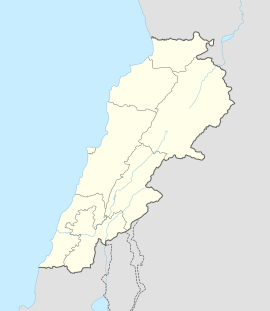 Roman ruins of Berytus, in front of Saint George Greek Orthodox Cathedral in modern-day Beirut | |
| Alternative name | Laodicea in Phoenicia (Ancient Greek: Λαοδίκεια ἡ ἐν Φοινίκῃ) or Laodicea in Canaan (2nd century to 64 BCE) |
|---|---|
| Location | Beirut, Lebanon |
| Coordinates | 33°53′44.8″N 35°30′18.5″E / 33.895778°N 35.505139°E |
| Type | Settlement |
| History | |
| Founded | Roman republic (merchants from early Laodicea/Berytus recorded by 110–109 BCE) |
| Periods | Roman and Early Byzantine/late antiquity; previous port dating back to Iron Age III and Persian periods |
| Cultures | Phoenician, Roman |
Berytus (/ˈbɛrɪtəs, bəˈraɪtəs/;[1] Phoenician: 𐤁𐤓𐤕, romanized: Biruta; Ancient Greek: Βηρυτός, romanized: Bērytós; Latin: Bērȳtus; Arabic: بَيرُوتَة), briefly known as Laodicea in Phoenicia (Ancient Greek: Λαοδίκεια ἡ ἐν Φοινίκῃ; Arabic: لاذقية كنعان) or Laodicea in Canaan from the 2nd century to 64 BCE, was the ancient city of Beirut (in modern-day Lebanon) from the Roman Republic through the Roman Empire and Early Byzantine period/late antiquity. [2] Berytus became a Roman colonia that would be the center of Roman presence in the Eastern Mediterranean shores south of Anatolia.[3]
The veterans of two Roman legions under Augustus were established in the city (the fifth Macedonian and the third Gallic), that afterward quickly became Romanized. It was the only fully Latin-speaking city in the Syria-Phoenicia region until the fourth century. Although Berytus was still an important city after earthquakes, around 400 CE Tyre was made the capital of the Roman province of Phoenicia. "Of the great law schools of Rome, Constantinople, and Berytus", the law school of Berytus stood "pre-eminent".[4] The Code of Justinian (one part of the Corpus Juris Civilis, the codification of Roman law ordered early in the 6th century CE by Justinian I and fully written in Latin) was mostly created in this school.
- ^ Worcester, Joseph E. (1861) An Elementary Dictionary of the English Language, Boston: Swan, Brewer & Tileston, page 326
- ^ The city had been rebuilt by the Seleucids in the 2nd century BCE over the ruins of an older settlement centred on a Phoenician port dating back to Iron Age III and Persian periods
- ^ Theodore Mommsen."The Provinces of the Roman Empire" Chapter: Phoenicia
- ^ Scott, Samuel Parsons (1973). The Civil Law, Including the Twelve Tables: The Institutes of Gaius, the Rules of Ulpian, the Opinions of Paulus, the Enactments of Justinian, and the Constitutions of Leo. AMS Press. ISBN 9780404110321.
